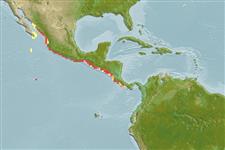Ελασμοβράγχιοι (καρχαρίες και σαλάχια) (sharks and rays) >
Torpediniformes (Electric rays) >
Narcinidae (Numbfishes)
Etymology: Narcine: Greek, narke = numbness (Ref. 45335).
Environment: milieu / climate zone / depth range / distribution range
Οικολογία
Θαλασσινό(ά) βενθικό(ς); εύρος βάθους 10 - 60 m (Ref. 91172), usually ? - 40 m (Ref. 114953). Tropical; 28°N - 8°N, 112°W - 82°W (Ref. 114953)
Eastern Central Pacific: Gulf of California to Panama.
Μέγεθος / Βάρος / Age
Maturity: Lm ? range ? - ? cm
Max length : 60.0 cm TL αρσενικό/απροσδιόριστο; (Ref. 9259)
Benthic, on soft bottoms in protected coastal areas. Males mature at ca. 19 cm TL; born at ca. 6 cm TL (Ref. 114953).
Life cycle and mating behavior
Γεννητική Ωρίμανση | Αναπαραγωγή | Γεννοβολία | Αβγά | Γονιμότητα | Προνύμφες
McEachran, J.D., 1995. Narcinidae. Rayas eléctricas. p. 769-771. In W. Fischer, F. Krupp, W. Schneider, C. Sommer, K.E. Carpenter and V. Niem (eds.) Guia FAO para Identification de Especies para los Fines de la Pesca. Pacifico Centro-Oriental. 3 Vols. FAO, Rome. (Ref. 9259)
IUCN Red List Status (Ref. 130435: Version 2024-1)
Human uses
Εργαλεία
Special reports
Download XML
Διαδικτυακές πηγές
Estimates based on models
Preferred temperature (Ref.
123201): 23.1 - 29, mean 26.4 °C (based on 42 cells).
Phylogenetic diversity index (Ref.
82804): PD
50 = 0.5000 [Uniqueness, from 0.5 = low to 2.0 = high].
Bayesian length-weight: a=0.00977 (0.00362 - 0.02638), b=2.69 (2.49 - 2.89), in cm total length, based on LWR estimates for this species & (Sub)family-body (Ref.
93245).
Τροφικό Επίπεδο (Ref.
69278): 3.1 ±0.3 se; based on size and trophs of closest relatives
Ελαστικότητα (Ref.
120179): Χαμηλό, ελάχιστος χρόνος για διπλασιασμό πληθυσμού 4,5 - 14 έτη (Assuming fecundity<100).
Fishing Vulnerability (Ref.
59153): Moderate vulnerability (44 of 100).
